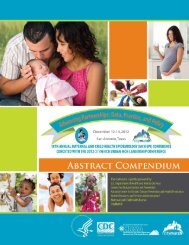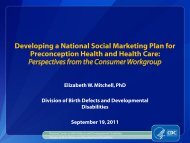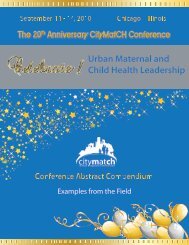Conference Abstract Compendium Examples from the ... - CityMatCH
Conference Abstract Compendium Examples from the ... - CityMatCH
Conference Abstract Compendium Examples from the ... - CityMatCH
Create successful ePaper yourself
Turn your PDF publications into a flip-book with our unique Google optimized e-Paper software.
2009 <strong>CityMatCH</strong> Urban MCH Leadership <strong>Conference</strong>RESULTSPedNSS data revealed a positive trend in <strong>the</strong> first two years of data analyzed, with <strong>the</strong> percent of childrenaged two to four years who were “overweight” decreasing <strong>from</strong> 19.4% in 2006 to 17.9% in 2007.Between 05-06 and 06-07, CHKS data likewise revealed positive trends, with improvement in lightexercise (increasing <strong>from</strong> a mean of 3.44 to 3.53 times per week) and in fruit consumption (increasing<strong>from</strong> a mean of 1.85 to 2.09 times per day).In <strong>the</strong> CPFT, improvement in <strong>the</strong> percentage of children passing 6 out of 6 fitness standards was evidentin both genders and all racial/ethnic groups between 05-06 and 06-07. <strong>Examples</strong> include overallimprovement (<strong>from</strong> 35.1% to 38.1%), and improvement in <strong>the</strong> Hispanic (<strong>from</strong> 23.4% to 26.1%) andChinese (<strong>from</strong> 51.2% to 53.9%) populations.Three years of data were analyzed for Task Force member surveys (05-06, 06-07 and 07-08). Each year30 or more people completed <strong>the</strong> surveys, approximately one-half of active GHSMC members. Onequestion asked members if <strong>the</strong>y “have increased confidence in County's ability to address this healthissue.” The percentages for “strongly agree” plus “agree” changed <strong>from</strong> 86% to 78% to 84% over <strong>the</strong>three years.Accomplishments (e.g., creation of <strong>the</strong> clearinghouse www.ge<strong>the</strong>althysmc.org), challenges (e.g., underrepresentationby youth and under-served communities) and recommendations (e.g, highlight local workduring Task Force meetings) were identified by all eight committees.LIMITATIONSThe data collected only begin to describe <strong>the</strong> complex factors influencing child health, nutrition andphysical activity indicators, and health outcomes. Existing data sources describe certain populations,namely, low-income children (PedNSS), and children in participating public schools (CPFT and CHKS).Task Force member surveys capture information <strong>from</strong> about one-half of regular Task Force members.CONCLUSIONS/IMPLICATIONSThese data suggest improvement in nutrition and physical activity indicators for San Mateo Countychildren – ongoing assessment is needed to see if <strong>the</strong>se trends continue. New data sources are beingidentified and analyzed to provide a broader picture of environmental impacts on health (e.g., availabilityof healthy food options in neighborhoods). The work of engaging diverse stakeholders and providing<strong>the</strong>m with clear benefits <strong>from</strong> participation in <strong>the</strong> GHSMC Task Force is ongoing.125







